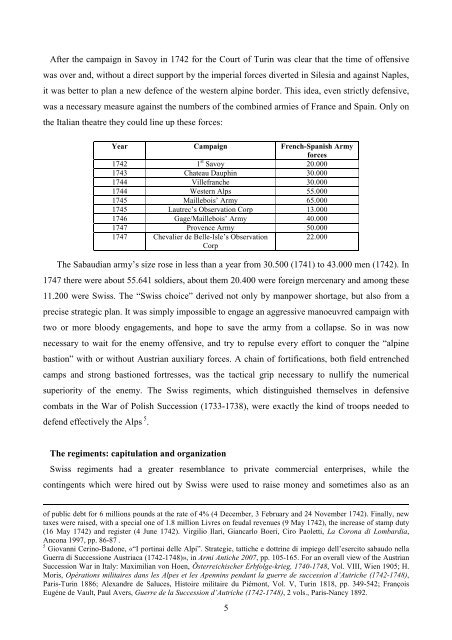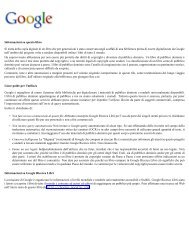Cerino-Badone, Swiss Regiments - Libreria Militare Ares
Cerino-Badone, Swiss Regiments - Libreria Militare Ares
Cerino-Badone, Swiss Regiments - Libreria Militare Ares
- No tags were found...
Create successful ePaper yourself
Turn your PDF publications into a flip-book with our unique Google optimized e-Paper software.
After the campaign in Savoy in 1742 for the Court of Turin was clear that the time of offensive<br />
was over and, without a direct support by the imperial forces diverted in Silesia and against Naples,<br />
it was better to plan a new defence of the western alpine border. This idea, even strictly defensive,<br />
was a necessary measure against the numbers of the combined armies of France and Spain. Only on<br />
the Italian theatre they could line up these forces:<br />
Year Campaign French-Spanish Army<br />
forces<br />
1742 1 st Savoy 20.000<br />
1743 Chateau Dauphin 30.000<br />
1744 Villefranche 30.000<br />
1744 Western Alps 55.000<br />
1745 Maillebois’ Army 65.000<br />
1745 Lautrec’s Observation Corp 13.000<br />
1746 Gage/Maillebois’ Army 40.000<br />
1747 Provence Army 50.000<br />
1747 Chevalier de Belle-Isle’s Observation<br />
Corp<br />
22.000<br />
The Sabaudian army’s size rose in less than a year from 30.500 (1741) to 43.000 men (1742). In<br />
1747 there were about 55.641 soldiers, about them 20.400 were foreign mercenary and among these<br />
11.200 were <strong>Swiss</strong>. The “<strong>Swiss</strong> choice” derived not only by manpower shortage, but also from a<br />
precise strategic plan. It was simply impossible to engage an aggressive manoeuvred campaign with<br />
two or more bloody engagements, and hope to save the army from a collapse. So in was now<br />
necessary to wait for the enemy offensive, and try to repulse every effort to conquer the “alpine<br />
bastion” with or without Austrian auxiliary forces. A chain of fortifications, both field entrenched<br />
camps and strong bastioned fortresses, was the tactical grip necessary to nullify the numerical<br />
superiority of the enemy. The <strong>Swiss</strong> regiments, which distinguished themselves in defensive<br />
combats in the War of Polish Succession (1733-1738), were exactly the kind of troops needed to<br />
defend effectively the Alps 5 .<br />
The regiments: capitulation and organization<br />
<strong>Swiss</strong> regiments had a greater resemblance to private commercial enterprises, while the<br />
contingents which were hired out by <strong>Swiss</strong> were used to raise money and sometimes also as an<br />
of public debt for 6 millions pounds at the rate of 4% (4 December, 3 February and 24 November 1742). Finally, new<br />
taxes were raised, with a special one of 1.8 million Livres on feudal revenues (9 May 1742), the increase of stamp duty<br />
(16 May 1742) and register (4 June 1742). Virgilio Ilari, Giancarlo Boeri, Ciro Paoletti, La Corona di Lombardia,<br />
Ancona 1997, pp. 86-87 .<br />
5 Giovanni <strong>Cerino</strong>-<strong>Badone</strong>, «“I portinai delle Alpi”. Strategie, tattiche e dottrine di impiego dell’esercito sabaudo nella<br />
Guerra di Successione Austriaca (1742-1748)», in Armi Antiche 2007, pp. 105-165. For an overall view of the Austrian<br />
Succession War in Italy: Maximilian von Hoen, Österreichischer Erbfolge-krieg, 1740-1748, Vol. VIII, Wien 1905; H.<br />
Moris, Opérations militaires dans les Alpes et les Apennins pendant la guerre de succession d’Autriche (1742-1748),<br />
Paris-Turin 1886; Alexandre de Saluces, Histoire militaire du Piémont, Vol. V, Turin 1818, pp. 349-542; François<br />
Eugéne de Vault, Paul Avers, Guerre de la Succession d’Autriche (1742-1748), 2 vols., Paris-Nancy 1892.<br />
5
















